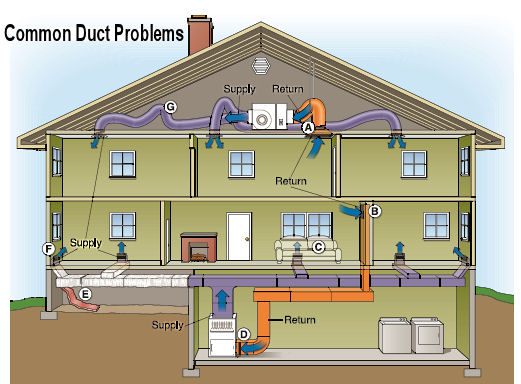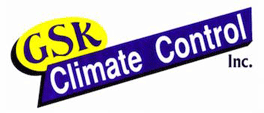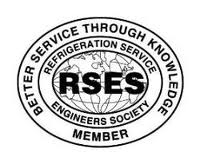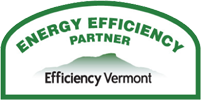The National Comfort Institute estimates that the typical U.S. duct system is only 57% efficient, due to implications from improperly installed, designed, and maintained HVAC ductwork. On average your home loses anywhere from 15%-40% of the conditioned air that’s circulated throughout the duct branches of your HVAC system. This equates to costly, inefficient operation, wasted energy, decreased equipment longevity due to un-necessary wear on your heating and cooling system, and increased discomfort to the building occupants.
If you’ve ever noticed drafts in certain parts of your home, rooms that are more difficult to heat or cool than others, or regular and unplanned temperature swings (especially during harsh weather), than your HVAC ductwork could be the cause! Unsealed, uninsulated, improperly balanced, damaged, or blocked ducts, dampers, supply registers, return grills, or vents can wreak havoc on the proper operation and condition of your HVAC equipment- not to mention your home’s comfort level! If an air leak is present, either from unsealed, uninsulated, or damaged ductwork, this can further exacerbate health issues and discomfort by allowing contaminants such as dust, mold, pollen, and pests, etc. to enter and recirculate through your home’s air passageways, affecting indoor air quality and consequently occupant health. 🙁
Continuing to operate your HVAC system in the presence of an air leak can actually worsen leakage due to the operation of the blowers and fans that transport conditioned air. These air distribution devices, establish positive or negative pressures (depending on system set-up) within the building, that can pull excess air from unconditioned spaces, thus accelerating air leakage, contaminant entry, and adding extra load to your HVAC equipment. The Environmental Protection Agency (EPA) approximates that the indoor air quality (IAQ) in your home could be anywhere from 5 to 100 times more polluted than outside air, due to both air leakage causes and the resultant contaminants that enter. An uncleaned or maintained duct system will further intensify the presence of contaminants in your system, as it will continue to disperse dirty air throughout the entire HVAC system and into your home.
It’s important that all ducts are sealed between the HVAC equipment and duct branches, at all the registers and grilles, and at each and every joint within the system. Improperly sealed supply and return registers can leak conditioned air before it ever enters the room. Leaky duct joints and leaky seals between the equipment or plenum and the duct system will also allow for the conditioned air you pay to heat or cool, to leak out of the system before it’s ever circulated into your home. Ductwork in unconditioned spaces should be insulated with a foil-faced fiberglass insulation to prevent excessively cold or hot ambient air from affecting the temperature and condition of the conditioned air running through the branches. Where ductwork is located in a crawlspace, basement, or attic, the presence of spiders and spider webs around a duct can signal a leaking duct, since spiders tend to live in areas where there’s free flowing air to catch bugs.
People spend on average 90% of their time indoors, even more so in the New England heating season. It’s essential to you and your family’s health and comfort to consider both the cleanliness and condition of you home’s HVAC distribution pathways. The American Lung Association estimates 50% of all illnesses can be linked to poor indoor air quality (IAQ). Don’t breath contaminated, stagnant, humid air from a leaking or poorly-maintained duct system! Improving home air filtration (i.e. changing furnace and/or HVAC unit air filters regularly), ductwork, and your building’s thermal envelope (i.e. insulation, door gaskets, old leaky windows, uninsulated plumbing and dryer vents, unsealed attic hatchways, covering exterior wall penetrations, etc.) can have a huge impact on your wellbeing, productivity, and comfort. These improvements will also save you a considerable amount of money on energy costs, since your equipment and it’s distribution system will be able to function more efficiently without intrusive and relentless air leakage. 🙂
802-362-5444
315 Tennis Way, Hills Industrial Park,
East Dorset, VT, 05253
check us out on Facebook!
blog by: Taylor Kristiansen






